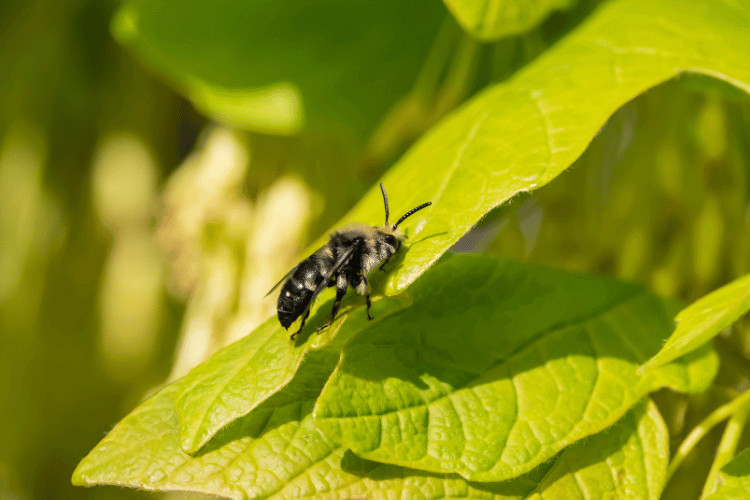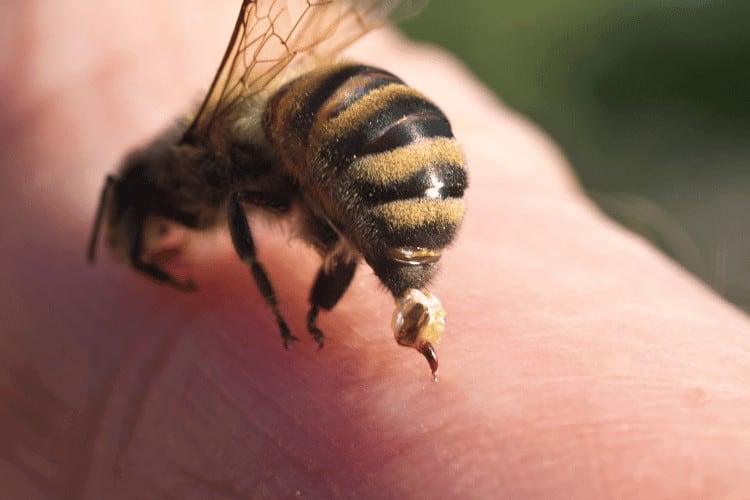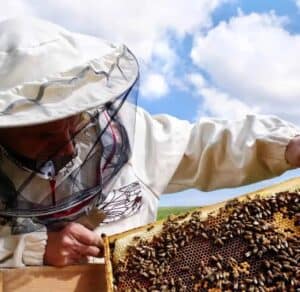Mourning Bees: Everything You Should Know
Mourning (not morning) bees are unique members among honey buzzers. In addition to producing honey, they pollinate other plants, distribute nutrients, and transfer seeds to the soil and other plants.
In this quick guide, we’ll discuss all there is to know about mourning bees!
What Are Mourning Bees?

Delving into the world of beekeeping, you’ll come across a distinct group of pollinators known as mourning bees, scientifically labeled as Melecta albifrons.
These bees bring a touch of fascination to the realm of pollinators, making them a noteworthy subject for both seasoned beekeepers and newcomers to the field.
The “Mourning” bees got the name for two reasons:
The first reason is because of their black bodies with white markings. This coloration is similar to the traditional clothing worn by mourners in many cultures.
The second reason is because of their behavior. Some mourning bees can be solitary bees, and they won’t live in colonies like honey bees or bumblebees. When a mourning bee dies, its body is left behind and its nest is abandoned. This may have led to the belief that mourning bees are always in mourning for their dead.
Characteristics of Mourning Bees
- Striking Appearance: Mourning bees are small, black bees with two white patches on the abdomen. They have brown hairs on their bodies and a long, tube-like tongue for sucking nectar from flowers.
- Cross-Pollination Champions: Mourning bees play a significant role in the ecosystem by actively engaging in cross-pollination. As they diligently gather nectar from flowers, including fruit trees and floral sprays, they facilitate the reproduction of various plant species. This vital process contributes to the health and diversity of ecosystems.
- Nectar Collectors and Honey Producers: Beyond their captivating appearance, mourning bees contribute to honey production through their nectar collection efforts. This aspect shows their importance not only to the environment but also to beekeepers who rely on honey production.
- Nocturnal Foragers: One particularly captivating trait of mourning bees is their activity during the night. These bees demonstrate a unique behavior by foraging for nectar under the cover of darkness.
What’s the Purpose of Mourning Bees?
Mourning bees are important pollinators. They help to pollinate a variety of plants, including fruit trees, vegetables, and wildflowers.
Mourning bees are also an important part of the ecosystem. They help to maintain healthy populations of plants and flowers, which in turn supports other wildlife.
Mourning Bees: Habitat and Foraging Preferences
Mourning bees are found in a variety of habitats, including meadows, forests, and gardens. They prefer to forage in open, sunny areas with plenty of flowers. Their foraging preferences include:
- Nectar-rich flowers: Mourning bees collect nectar from flowers to fuel their flight and to feed their young. They prefer flowers with a high concentration of nectar, such as dandelions, clover, and daisies.
- Pollen-rich flowers: Mourning bees also collect pollen to feed their young. They prefer flowers with a lot of pollen, such as sunflowers, hollyhocks, and zinnias.
- Fruit trees: Mourning bees are important pollinators of fruit trees, and they will often visit orchards to collect nectar and pollen.
- Native plants: Mourning bees prefer to forage on native plants, as they are more adapted to these plants and their pollen. If you want to attract mourning bees to your garden, plant native wildflowers and shrubs.
Where Can You Find Mourning Bees?
Mourning bees can be found in various locales. Here’s a glimpse of their favored haunts:
- Urban Greenspaces: These adaptable bees flourish even in urban environments, making parks, gardens, and green city areas their homes.
- Natural Soft Cliffs: Mourning bees demonstrate a knack for thriving on soft cliffs in nature, utilizing these habitats for nesting and foraging.
- Fruit Tree Orchards: Fruit trees offer an abundant source of nectar for these bees, drawing them to orchards where they play a vital role in cross-pollination.
- Native Floral Havens: Mourning bees exhibit a preference for native plants, making wildflower meadows and native gardens ideal for their foraging endeavors.

Mourning Bees Life Cycle, Mating, and Nesting
Here’s the lifecycle of Mourning Bees:
Egg to Larva
The journey of mourning bees begins as eggs are laid within the nests of other solitary bees. Once hatched, the larvae feed on the pollen provisions left behind by the host bee, fueling their growth.
Pupal Stage
Transitioning to the pupal stage, mourning bee larvae encase themselves in cocoons within their nests. During this stage, they undergo crucial metamorphosis before emerging as adults.
Emergence
Adult mourning bees, having completed their pupal development, emerge from their cocoons. This emergence, often occurring in the spring, marks a new phase in their life cycle.
Mating Rituals
The skies witness a captivating display as male and female mourning bees engage in mid-air mating rituals, a unique and mesmerizing behavior.
Nesting
Female mourning bees play a crucial role in the cycle by constructing underground nests. These nests serve as repositories for pollen and nectar provisions, ensuring the sustenance of their future offspring.
Importance of Mourning Bees in Ecosystems and Agriculture
Here are some of the specific importance of mourning bees in ecosystems and agriculture:
- Pollination: Mourning bees are important pollinators of a wide variety of plants, including fruit trees, vegetables, and wildflowers. They help to ensure that these plants are pollinated and can reproduce. This is essential for the maintenance of healthy ecosystems and for the production of food.
- Seed Dispersal: Mourning bees also help to disperse seeds by carrying them from one plant to another. This helps to ensure that plants can colonize new areas and create a more diverse range of plants in an ecosystem.
- Nutrient Cycling: Mourning bees help to cycle nutrients through ecosystems by carrying pollen and nectar from plants to other organisms. This helps to ensure that nutrients are available to all organisms in an ecosystem.
- Soil Health: Mourning bees help to improve soil health by carrying pollen and nectar from plants to the soil. This helps to create a more diverse range of bacteria and fungi in the soil, which is essential for healthy soil.
Common Questions About Mourning Bees
What Do Mourning Bees Eat?
Mourning Bees Eat:
- Nectar: Mourning bees collect nectar from flowers to fuel their flight. Nectar is a sugary liquid that is produced by flowers to attract pollinators. Mourning bees use their long, tube-like tongues to suck up nectar from flowers.
- Pollen: Mourning bees collect pollen to feed their young. Pollen is a fine powder that is produced by flowers. It contains proteins, fats, and other nutrients that are essential for the development of bee larvae. Mourning bees collect pollen on their bodies and then transport it back to their nests.
- Water: Mourning bees also need water to survive. They will often visit flowers that have dew on them or that are located near water sources.
Are Mourning Bees Dangerous?
Mourning bees are not generally considered to be dangerous, but that doesn’t mean they won’t sting.
However, mourning bees will sting if they feel threatened. If you are approached by a mourning bee, it is best to stay calm and move away slowly. Do not swat at the bee or make any sudden movements.

What Size Are Mourning Bees?
Mourning bees are small bees, measuring about 12-14mm in length. The female has a black body with two white patches on the abdomen. The male is smaller and has a black body with brown hair.
Mourning bees are often mistaken for wasps, but they are actually bees. Wasps are typically larger than bees and have thinner waists. They also have a more aggressive temperament and are more likely to sting.
How to Identify Mourning Bees?
Identifying mourning bees amidst the buzzing crowd can be an exciting endeavor. Look for distinctive features like their contrasting black bodies adorned with white hairs and patches of brown hairs. These unique markings make them stand out among other pollinators.
Pay attention to their behavior as well – their dedication to nectar collection, particularly from fruit trees and native floral sources, sets them apart.
How to Attract Mourning Bees?
You can easily get mourning bees to your garden by following those tips:
- Plant native wildflowers: Mourning bees prefer to visit flowers with a high concentration of nectar. They will also visit fruit trees and other flowering plants. When planting flowers in your garden, choose native wildflowers that are known to attract mourning bees.
- Provide nesting sites: Mourning bees nest in the ground, so you can provide them with nesting sites by creating small holes in the ground or by providing them with pre-made nest boxes. The holes should be about 1/2 inch in diameter and 3-4 inches deep. You can also purchase pre-made nest boxes for mourning bees online or at garden centers.
- Avoid using pesticides: Pesticides can kill mourning bees, so it is important to avoid using them in your garden. If you must use pesticides, choose products that are labeled as “bee-friendly.”
- Water your plants regularly: Mourning bees need water to survive, so it is important to water your plants regularly. You can also provide them with a shallow dish of water for them to drink from.
- Be patient: It may take some time to attract mourning bees to your garden, but if you provide them with the right habitat and conditions, they will eventually come.
Conclusion
Mourning bees are fascinating creatures that play an important role in the ecosystem. They aren’t only pollinators, but they also help to disperse seeds and improve soil health.
By providing mourning bees with the right habitat and food sources, you can help to ensure their survival and the health of our environment.

Joseph Davis
My goal is to show that anyone can take up beekeeping and it can be a very rewarding hobby. I strive to share my experiences and answer any questions you may have.
